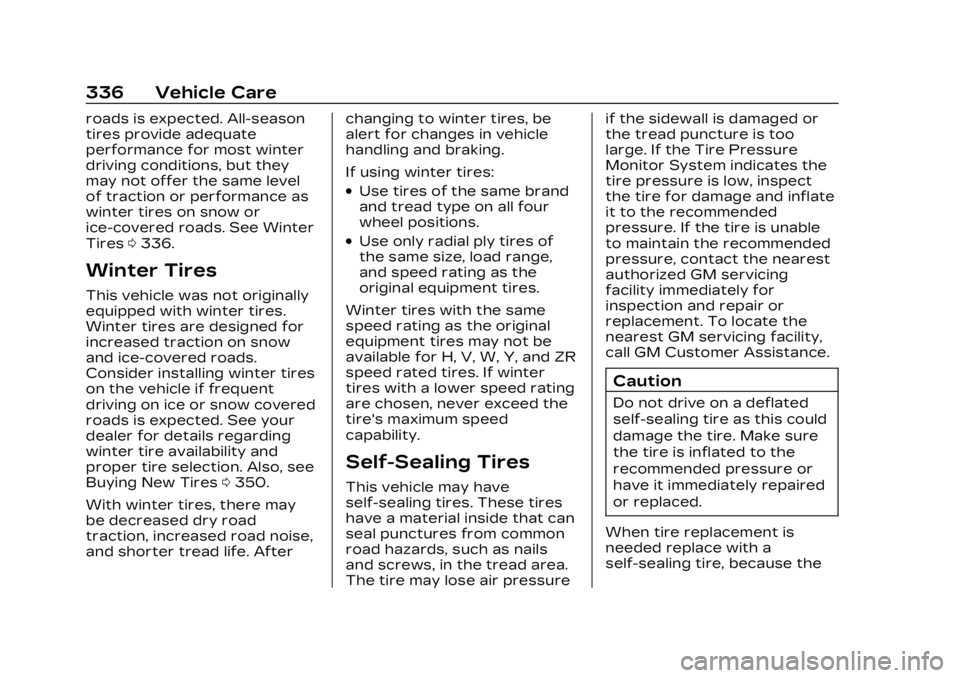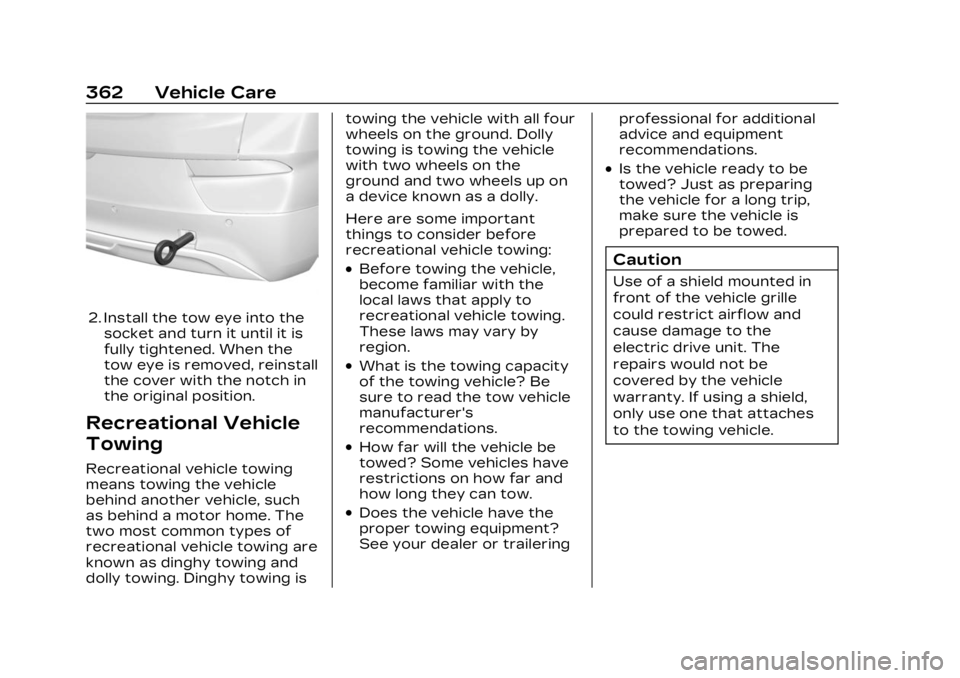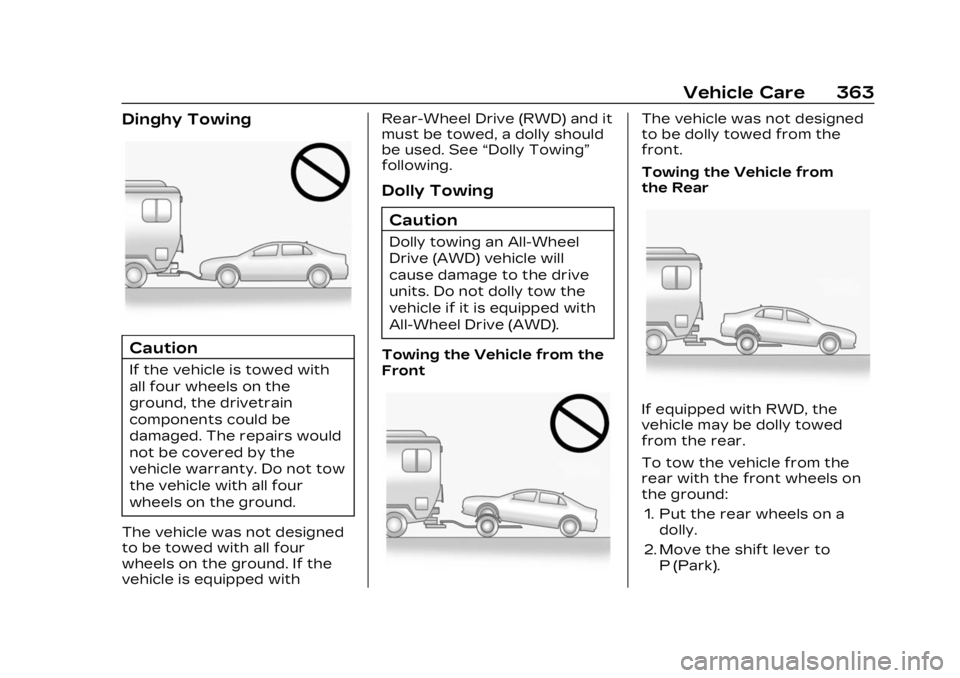Page 216 of 424

Cadillac Lyriq Owner Manual (GMNA-Localizing-U.S./Canada-15644413) -
2023 - CRC - 2/23/22
Driving and Operating 215
For faster access, One-Pedal
Driving can be toggled on the
Driver Mode screen. From the
infotainment display home
screen, select Drive Mode to
open the Drive Mode screen.
Touch
lto toggle One-Pedal
Driving on or off. When turned
on, One-Pedal Driving returns
to the previously selected
level. To change the level,
press the Settings link in the
pop-up box to go to the full
One-Pedal Driving selection.
When possible, One-Pedal
Driving uses regenerative
braking to slow the vehicle for
energy efficiency. Friction
brakes may be used in some
cases when regenerative
braking is reduced. Friction
brakes will be used to hold the
vehicle after coming to a stop,
and a noise may be noticed
when the brakes apply. When driving on slippery
roads, it is recommended to
turn off One-Pedal Driving.
See Winter Driving
0201.
While using One-Pedal Driving,
the Electric Parking Brake may
apply in some circumstances.
This can occur when:
.The driver exits the vehicle.
.The vehicle has remained
stationary for five minutes.
To resume driving, press the
accelerator pedal, and the
Electric Parking Brake will
automatically disengage.
Drive Systems
All-Wheel Drive
This vehicle may be equipped
with advanced electric
All-Wheel Drive (eAWD). The
eAWD system delivers power to all four wheels, and the
system adjusts automatically
to the driving conditions. The
eAWD system continuously
varies the drive power to the
front and rear wheels to
maximize driving efficiency and
improve driving dynamics.
Your vehicle has exceptional
driving capability, but care
must always be taken to
adjust driving style to the
traffic and road conditions.
The vehicle eAWD settings
may be customized for the
driver mode selected. See
Driver Mode Control
0223 for
more information.
Page 337 of 424

Cadillac Lyriq Owner Manual (GMNA-Localizing-U.S./Canada-15644413) -
2023 - CRC - 2/23/22
336 Vehicle Care
roads is expected. All-season
tires provide adequate
performance for most winter
driving conditions, but they
may not offer the same level
of traction or performance as
winter tires on snow or
ice-covered roads. See Winter
Tires0336.
Winter Tires
This vehicle was not originally
equipped with winter tires.
Winter tires are designed for
increased traction on snow
and ice-covered roads.
Consider installing winter tires
on the vehicle if frequent
driving on ice or snow covered
roads is expected. See your
dealer for details regarding
winter tire availability and
proper tire selection. Also, see
Buying New Tires 0350.
With winter tires, there may
be decreased dry road
traction, increased road noise,
and shorter tread life. After changing to winter tires, be
alert for changes in vehicle
handling and braking.
If using winter tires:
.Use tires of the same brand
and tread type on all four
wheel positions.
.Use only radial ply tires of
the same size, load range,
and speed rating as the
original equipment tires.
Winter tires with the same
speed rating as the original
equipment tires may not be
available for H, V, W, Y, and ZR
speed rated tires. If winter
tires with a lower speed rating
are chosen, never exceed the
tire's maximum speed
capability.
Self-Sealing Tires
This vehicle may have
self-sealing tires. These tires
have a material inside that can
seal punctures from common
road hazards, such as nails
and screws, in the tread area.
The tire may lose air pressure if the sidewall is damaged or
the tread puncture is too
large. If the Tire Pressure
Monitor System indicates the
tire pressure is low, inspect
the tire for damage and inflate
it to the recommended
pressure. If the tire is unable
to maintain the recommended
pressure, contact the nearest
authorized GM servicing
facility immediately for
inspection and repair or
replacement. To locate the
nearest GM servicing facility,
call GM Customer Assistance.
Caution
Do not drive on a deflated
self-sealing tire as this could
damage the tire. Make sure
the tire is inflated to the
recommended pressure or
have it immediately repaired
or replaced.
When tire replacement is
needed replace with a
self-sealing tire, because the
Page 363 of 424

Cadillac Lyriq Owner Manual (GMNA-Localizing-U.S./Canada-15644413) -
2023 - CRC - 2/23/22
362 Vehicle Care
2. Install the tow eye into thesocket and turn it until it is
fully tightened. When the
tow eye is removed, reinstall
the cover with the notch in
the original position.
Recreational Vehicle
Towing
Recreational vehicle towing
means towing the vehicle
behind another vehicle, such
as behind a motor home. The
two most common types of
recreational vehicle towing are
known as dinghy towing and
dolly towing. Dinghy towing is towing the vehicle with all four
wheels on the ground. Dolly
towing is towing the vehicle
with two wheels on the
ground and two wheels up on
a device known as a dolly.
Here are some important
things to consider before
recreational vehicle towing:
.Before towing the vehicle,
become familiar with the
local laws that apply to
recreational vehicle towing.
These laws may vary by
region.
.What is the towing capacity
of the towing vehicle? Be
sure to read the tow vehicle
manufacturer's
recommendations.
.How far will the vehicle be
towed? Some vehicles have
restrictions on how far and
how long they can tow.
.Does the vehicle have the
proper towing equipment?
See your dealer or trailering
professional for additional
advice and equipment
recommendations.
.Is the vehicle ready to be
towed? Just as preparing
the vehicle for a long trip,
make sure the vehicle is
prepared to be towed.
Caution
Use of a shield mounted in
front of the vehicle grille
could restrict airflow and
cause damage to the
electric drive unit. The
repairs would not be
covered by the vehicle
warranty. If using a shield,
only use one that attaches
to the towing vehicle.
Page 364 of 424

Cadillac Lyriq Owner Manual (GMNA-Localizing-U.S./Canada-15644413) -
2023 - CRC - 2/23/22
Vehicle Care 363
Dinghy Towing
Caution
If the vehicle is towed with
all four wheels on the
ground, the drivetrain
components could be
damaged. The repairs would
not be covered by the
vehicle warranty. Do not tow
the vehicle with all four
wheels on the ground.
The vehicle was not designed
to be towed with all four
wheels on the ground. If the
vehicle is equipped with Rear-Wheel Drive (RWD) and it
must be towed, a dolly should
be used. See
“Dolly Towing”
following.
Dolly Towing
Caution
Dolly towing an All-Wheel
Drive (AWD) vehicle will
cause damage to the drive
units. Do not dolly tow the
vehicle if it is equipped with
All-Wheel Drive (AWD).
Towing the Vehicle from the
Front
The vehicle was not designed
to be dolly towed from the
front.
Towing the Vehicle from
the Rear
If equipped with RWD, the
vehicle may be dolly towed
from the rear.
To tow the vehicle from the
rear with the front wheels on
the ground: 1. Put the rear wheels on a dolly.
2. Move the shift lever to P (Park).